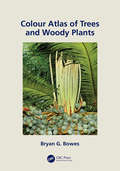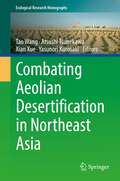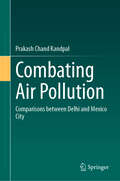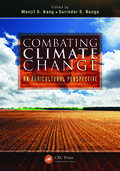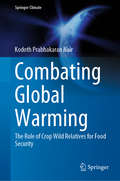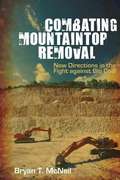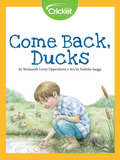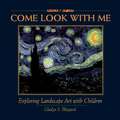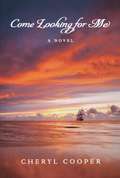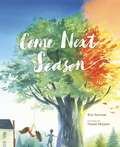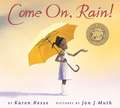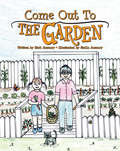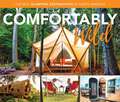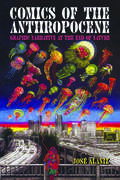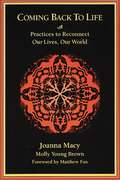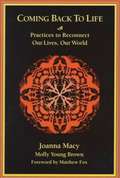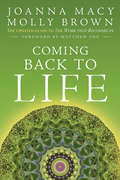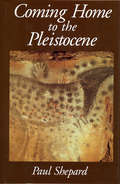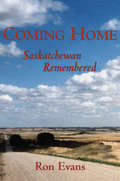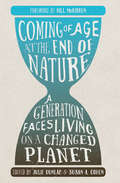- Table View
- List View
Colour Atlas of Woody Plants and Trees
by Bryan G. BowesTrees and plants are important components of the human environment having significant presence beyond agricultural and recreational values. Colour Atlas of Woody Plants and Trees presents a photographic compilation of morphological features of trees and shrubs giving attention to their unique aspects not presented in existing books. By increasing awareness to users through high quality, full-color photographs and informative text, this book demonstrates the enormous diversity of vascular trees and plants living today. Features: Full color atlas offers concise, but highly informative text accompanied by over 200 high-resolution digital tree images Contains images of the anatomy of tree structures and evolution of the most important features of trees Presents information on the varied structure and morphology exhibited by trees and demonstrates their vital importance in the current struggle for the survival of our human society Surveys the most important morphological features of plants, shrubs and trees Presents aspects of plants and trees both common and rarely seen in nature Bryan Geoffrey Bowes is a retired Senior Lecturer in the Botany Department at Glasgow University and was a Research Fellow in ETH Zurich, Harvard University, and University of New England, Australia. His research interests encompass plant anatomy and ultrastructure, plant regeneration, and morphogenesis in vitro.
Combating Aeolian Desertification in Northeast Asia (Ecological Research Monographs)
by Tao Wang Atsushi Tsunekawa Xian Xue Yasunori KurosakiThis book presents the definition of aeolian desertification and uncovers its processes, driving factors, and consequences, and focuses on measures to effectively combat aeolian desertification in Northeast Asia. Aeolian desertification in Northeast Asia is of great concern for its destructive influences on the environment and society not only in the local but also in faraway areas. The topics of this book are addressed by compiling theoretical review, remote sensing monitoring, synoptic analysis, and laboratory and field studies in China, Japan, and Mongolia. This is the first comprehensive book to address the aeolian desertification in Northeast Asia. Readers can learn the basic theory of aeolian desertification and the primary causes of this environmental problem. More critical is the successful practical countermeasures to combat desertification which can be referred to by various stakeholders who concern the aeolian desertification in Northeast Asia. To meet the Sustainable Development Goals of the United Nations adopted in 2015, especially its Goal 15.3 to achieve a land degradation-neutral world by 2030, desertification combating actions should be taken cross country borders. This book is not only intended for environmental professionals but also for people who are affected and concerned about desertification and land degradation. The concept and processes in this book will serve as a ready reference to understand the aeolian desertification with countermeasures and successful preventing stories that can be referred to.
Combating Air Pollution: Comparisons between Delhi and Mexico City
by Prakash Chand KandpalThe primary objective of this book is to probe into the menace of air pollution in Delhi, which has emerged as the main threat to public health and the environment in the capital city. The book explores the viable solutions to the problem, examines the existing policies and programmes developed by the Government and the policy makers to address the issue, traverse the hurdles in the implementation of these policies and reveals the politics over air pollution in Delhi. It also discusses about the other highly polluted cities of the world, specifically Mexico City, which has faced environmental emergencies due to air pollution in the past, and how these cities have prepared themselves to combat the menace of air pollution, and what can be learnt from their experiences to face the same situations in Delhi. The book examines how air pollution is being addressed in the context of environmental policy frameworks and politics, and will be of use to policy makers, researchers, governmental and non-governmental agencies working to combat air pollution in major cities.
Combating Climate Change: An Agricultural Perspective
by Manjit S. Kang Surinder S. BangaThe effects of climate change can already be felt around the world, and they will likely impact all facets of human civilization-from health, livelihood security, agricultural production, and shelter to international trade. Since anthropogenic factors are mainly to blame for the current trends in global warming, human intervention will be necessary
Combating Global Warming: The Role of Crop Wild Relatives for Food Security (Springer Climate)
by Kodoth Prabhakaran NairThis book critically examines the environmental hazards posed by global warming with regard to future food security, which will depend on a combination of stresses, both biotic and abiotic, imposed by climate change; variability of weather within a growing season; and the development of cultivars that are more sensitive to different ambient conditions. Furthermore, the ability to develop effective adaptive strategies which allow these cultivars to express their genetic potential under changing climate conditions will be essential. In turn, the book investigates those plant species which are very closely related to field crops and have the potential to contribute beneficial traits for crop improvement, e.g. resistance to a wide range of biotic and abiotic stresses, enriching the gene pool, and ultimately leading to enhanced plant yield, known as “Crop Wild Relatives” (CWRs). CWRs hold tremendous potential to sustain and enhance global food security, contributing to human well-being. Accordingly, their development, characterization and conservation in crop breeding programs have assumed great practical importance.Professor Kodoth Prabhakaran Nair is an internationally acclaimed agricultural scientist, with over three decades of experience in Europe, Africa and Asia, holding some of the most prestigious academic positions, including the National Chair of the Science Foundation, The Royal Society, Belgium. A Senior Fellow of the world renowned Alexander von Humboldt Research Foundation of The Federal Republic of Germany, he is best known, globally, for having developed a revolutionary soil management technique, known as "The Nutrient Buffer Power Concept", which, while questioning the scientific fallacies of the highly soil extractive farming, euphemistically known as the "green revolution", has opened up an alternative path for sensible and scientific soil management
Combating Mountaintop Removal: New Directions in the Fight against Big Coal
by Bryan T. McNeilDrawing on powerful personal testimonies of the hazards of mountaintop removal in southern West Virginia, Combating Mountaintop Removal critically examines the fierce conflicts over this violent and increasingly prevalent form of strip mining. Bryan T. McNeil documents the changing relationships among the coal industry, communities, environment, and economy from the perspective of local grassroots activist organizations and their broader networks. Focusing on Coal River Mountain Watch (CRMW), an organization composed of individuals who have personal ties to the coal industry in the region, the study reveals a turn away from once-strong traditional labor unions and the emergence of community-based activist organizations. By framing social and moral arguments in terms of the environment, these innovative hybrid movements take advantage of environmentalism's higher profile in contemporary politics. In investigating the local effects of globalization and global economics, McNeil tracks the profound reimagining of social and personal ideas such as identity, history, and landscape and considers their roles in organizing an agenda for progressive community activism.
Come Back to Me (A Seal Island novel): A gripping love story from the author of THE ITALIAN VILLA
by Daniela SacerdotiFrom the bestselling author of The Italian Villa and Watch Over Me, a romantic, moving and uplifting story of three different lives, connected by a thread. Perfect for anyone who loves Fiona Valpy and Lily Graham.'Atmospheric, romantic and compelling. Daniela writes with huge warmth and sincerity' Rosanna LeyThree separate lives. Three broken hearts.Haunted by his wife's death, Matt arrives on Seal Island determined to be alone and unable to escape his grief. In the island's hospital, a young woman named Rose lies in a coma, trapped by the memories of events leading up to her accident. Grace, the island's doctor, is at the heart of the community. Only she knows how much she regrets turning down the chance of love and a family years ago.For these three people hope seems gone. But life is about to offer an unexpected new beginning...Readers adore the captivating novels of Daniela Sacerdoti'A love story that will satisfy even the most hopeless romantics' Daily Express'Beautifully written and atmospheric' The Sun 'A great book' Lesley Pearse'Emotional. I couldn't put it down' Daily Mail'I fell in love with this book' Prima magazine
Come Back to Me (A Seal Island novel): A gripping love story from the author of THE ITALIAN VILLA
by Daniela SacerdotiFrom the bestselling author of WATCH OVER ME, Daniela Sacerdoti's latest Seal Island novel is a romantic, moving and uplifting story of three different lives, connected by a thread.** Over 1 million copies sold of Daniela Sacerdoti's novels **When all seems lost...Matt - grief-stricken after his beloved wife's death, he arrives on Seal Island desperate to hide from the world.Grace - the island's doctor believes she's left it too late to find love or have a family.Rose - lying in a coma at a hospital on Seal, a young woman fights for her life, recalling the journey that led to her accident. ...life can surprise you with a new beginning.(P)2019 Headline Publishing Group Ltd
Come Back, Ducks
by Shulamith Levey OppenheimA young boy watches the ducks in his family's pond and wonders why they've suddenly left one day.
Come Look with Me: Exploring Landscape Art with Children
by Gladys S. BlizzardThe book presents children with a variety of artists and styles and helps them discover for themselves the ageless pleasure great art provides.
Come Looking for Me: A Novel
by Cheryl CooperIn Come Looking for Me, a mysterious young English woman named Emily risks a crossing of the Atlantic during the War of 1812 for the promise of a new adventure in Canada. But she never arrives. Captured by Captain Trevelyan, a man as cold-blooded as his frigate is menacing, Emily is held prisoner aboard the USS Serendipity. Seeking to save herself, she makes a desperate escape overboard in the midst of a raging sea battle and is rescued by the British crew of HMS Isabelle. Yet Emily has only exchanged one form of captivity for another, and remains in peril as England escalates its fight against the United States on the Atlantic. On board the Isabelle, Emily encounters a crew of fascinating seamen and strikes up unexpected friendships, but life on a man-of-war is full of deprivations and dangers to which she is unaccustomed. Amidst heartache and tragedy at sea, she struggles to find her place among the men until a turn of events reveals her true identity. And when Trevelyan’s ship once again looms on the horizon, Emily fears losing the only man she has ever loved and falling into the hands of the only man she has ever loathed. Come Looking for Me is a rich and compelling story of love and courage, friendship and treachery, triumph and loss. With humour and poignancy, author Cheryl Cooper captures all the colour, detail, and excitement of the great ships from the golden age of sail, while bringing to life those who fought upon them. She tells a story of the bravery of the men locked in the epic, brutal struggle that was the War of 1812, and the courage of a woman who, with extraordinary determination, labours to make her own way in life and in love.
Come Next Season
by Kim NormanWinner of the Northern Lights Nature AwardA gorgeous picture book that celebrates the magic of the seasons and the joys of family.Come next season . . . The lake will sparkle. The leaves will fall from the trees. We’ll play all day in the snow. We’ll visit the farm—and maybe make a friend.Every season is full of its own magic, every change brings new excitement, and every experience is better when it’s shared. With poetic text from bestselling author Kim Norman, brought to life by critically acclaimed illustrator Daniel Miyares, Come Next Season is a celebration of nature, adventure, and family—all year round.
Come On, Rain
by Karen Hesse"Come on, Rain!" Tess pleads to the sky as listless vines and parched plants droop in the endless heat. Then the clouds roll in and the rain pours. And Tess, her friends, and their mothers join in together in a rain dance to celebrate the shower that renews both body and spirit.
Come Out to the Garden
by Rick January“Come out to the garden,” Granny calls to Mary Louise. It’s a beautiful, sunny day, and there are vegetables to be picked and a feast to be cooked! But Mary Louise points out there are plenty of vegetables growing in the cool shade of the porch, so why go out in the sun? Together they pick baskets of corn, beans, and other vegetables, then cook them up and make a tasty, healthy feast. Come join the rhyme and discover the reason why Granny and Mary are dozing in the sun and purring like the cat. Maybe tomorrow, you too can pick some turnips and peas!
Come Spring
by Ben A. WilliamsAn historical novel, based on a real-life family who, with their large brood, helped found a frontier village in Maine during the Revolutionary war. The attempt in this book has been to tell the story of the founding of Union, a small Maine town, by ordinary people, in what was then an ordinary way. It was the way in which towns were founded from the Atlantic seaboard west to the great plains, by stripping off the forest and putting the land to work. People like these made this country, and towns like this one were and are the soil in which this country’s roots are grounded.
Comfortably Wild: The Best Glamping Destinations in North America
by Mike Howard Anne HowardThink outside the big-box hotels and discover North America&’s most inspiring outdoor getaways. In the first travel guide of its kind, authors Mike and Anne Howard of the acclaimed blog HoneyTrek.com dive into the origins of glamping and the 21st-century craving for unconventional experiences that effortlessly connect us with nature, family, and ourselves. Each chapter of Comfortably Wild offers a unique way to vacation, like the boutique farmstays in &“Cultivate,&” wellness retreats in "Rejuvenate,&” and action-packed journeys of &“In Motion.&” Alongside hundreds of gorgeous photographs and inspiring stories from the Howards&’ 73,000-mile quest, this glamping book offers practical tips to find your ideal destinations and to mobilize a lifetime of unforgettable adventures.Comfortably Wild features:Over 70 destinations across 9 countries, plus 80 extra getaways by region in the book&’s North America Glamping DirectoryRoundups of unique outdoor accommodations at vineyards, wildlife sanctuaries, hot springs, state parks, and moreHoneyTrek Tips offering the best deals, local secrets, and tested-and-approved travel adviceVacation Matchmaker pinpointing the best glamping getaways for your trip styleRandom Awesomeness featuring wacky one-of-a-kind destinations from cave mansions to ski-on-ski-off treehousesPacking lists, cooking ideas, handy apps, and booking sites to get outdoors with ease
Comics of the Anthropocene: Graphic Narrative at the End of Nature
by José AlanizSince the first Earth Day in 1970, how have US comics artists depicted the human-caused destruction of the natural world? How do these representations manifest in different genres of comics like superheroes, biography, underground comix, and journalism? What resources unique to the comics medium do they bring to their tasks? How do these works resonate with the ethical and environmental issues raised by global conversations about the anthropogenic sixth mass extinction and climate change? How have comics mourned the loss of nature over the last five decades? Are comics “ecological objects,” in philosopher Timothy Morton’s parlance? Weaving together insights from comics studies, environmental humanities, critical animal studies, and affect studies to answer these questions, Comics of the Anthropocene: Graphic Narrative at the End of Nature explores the representation of animals, pollution, mass extinctions, and climate change in the Anthropocene Era, our current geological age of human-induced environmental transformation around the globe. Artists and works examined in Comics of the Anthropocene include R. Crumb, Don McGregor et al.’s Black Panther, Jack Kirby’s Kamandi: The Last Boy on Earth, the comics of the Pacific Northwest, and Stephen Murphy and Michael Zulli’s landmark alternative series The Puma Blues. This book breaks new ground in confronting our most daunting modern crisis through a discussion of how graphic narrative has uniquely addressed the ecology issue.
Coming Back to Life
by Joanna R. Macy Molly Young BrownMany of us feel called to respond to the ecological destruction of our planet, yet we feel overwhelmed, immobilized, and unable to deal realistically with the threats to life on Earth. Noted spiritual and environmental thinkers Joanna Macy and Molly Young Brown contend that this crippling response to world crisis is a psychological defense mechanism that has been endemic since the years of the Cold War arms race, when we had to adapt within a single generation to the horrific possibility of nuclear holocaust.Since its publication in 1983, Joanna Macy's book, Despair and Personal Power in the Nuclear Age has sold nearly 30,000 copies and has been the primary resource for groups of men and women confronting the challenging realities of our time without succumbing to paralysis or panic. Coming Back to Life provides a much needed update and expansion of this pioneering work. At the interface between spiritual breakthrough and social action, Coming Back to Life is eloquent and compelling as well as being an inspiring and practical guide. The first third of the book discusses with extraordinary insight the angst of our era, and the pain, fear, guilt and inaction it has engendered; it then points forward to the way out of apathy, tio "the work that reconnects". The rest of the book offers both personal counsel and easy-to-use methods for working with groups in a number of ways to profoundly affect peoples' outlook and ability to act in the world.Table of ContentsForeword by Mathew Fox1. To Choose Life2. The Greatest Danger: Apatheia, The Deadening of Mind & Heart3. The Basic Miracle: Our True Nature & Power4. The Work that Reconnects5. Guiding Group Work6. Affirmation: Coming from Gratitude7. Despair Work: Owning & Honoring Our Pain for the World8. The Shift: Seeing with New Eyes9. Deep Time: Drawing on Past & Future Generations10. The Council of All Beings: Rejoining the Natural World11. Going Forth12. Meditations for Coming Back to LifeJoanna Macy has developed an international following over the course of 40 years as a speaker and workshop leader on Buddhist philosophy and the deep ecology movement
Coming Back to Life: Practices to Reconnect Our Lives, Our World
by Joanna R. Macy Molly Young BrownMany of us feel called to respond to the ecological destruction of our planet, yet we feel overwhelmed, immobilized, and unable to deal realistically with the threats to life on Earth. Noted spiritual and environmental thinkers Joanna Macy and Molly Young Brown contend that this crippling response to world crisis is a psychological defense mechanism that has been endemic since the years of the Cold War arms race, when we had to adapt within a single generation to the horrific possibility of nuclear holocaust. Since its publication in 1983, Joanna Macy's book, Despair and Personal Power in the Nuclear Age has sold nearly 30,000 copies and has been the primary resource for groups of men and women confronting the challenging realities of our time without succumbing to paralysis or panic. Coming Back to Life provides a much needed update and expansion of this pioneering work. At the interface between spiritual breakthrough and social action, Coming Back to Life is eloquent and compelling as well as being an inspiring and practical guide. The first third of the book discusses with extraordinary insight the angst of our era, and the pain, fear, guilt and inaction it has engendered; it then points forward to the way out of apathy, tio "the work that reconnects". The rest of the book offers both personal counsel and easy-to-use methods for working with groups in a number of ways to profoundly affect peoples' outlook and ability to act in the world.
Coming Back to Life: The Updated Guide to The Work that Reconnects
by Matthew Fox Molly Young Brown Joanna MacyDeepening global crises surround us. We are beset by climate change, fracking, tar sands extraction, GMOs, and mass extinctions of species, to say nothing of nuclear weapons proliferation and Fukushima, the worst nuclear disaster in history. Many of us fall prey to despair even as we feel called to respond to these threats to life on our planet.Authors Joanna Macy and Molly Brown address the anguish experienced by those who would confront the harsh realities of our time. In this fully updated edition of Coming Back to Life, they show how grief, anger, and fear are healthy responses to threats to life, and when honored can free us from paralysis or panic, through the revolutionary practice of the Work that Reconnects. New chapters address working within the corporate world, and engaging communities of color as well as youth in the Work.The Work that Reconnects has spread around the world, inspiring hundreds of thousands to work toward a life-sustaining human culture. Coming Back to Life introduces the Work's theoretical foundations, illuminating the angst of our era with extraordinary insight. Pointing the way forward out of apathy, it offers personal counsel as well as easy-to-use methods for group work that profoundly affect peoples' outlook and ability to act in the world.Joanna Macy is a scholar, eco-philosopher, teacher, activist, and author of twelve previous books including Coming Back to Life.Molly Young Brown is a teacher, trainer, counselor, and author of four previous books on psychology and Earth-based spirituality.
Coming Clean
by Michael BruneThe catastrophic release of oil into the Gulf of Mexico by BP's Deepwater Horizon well has been a wake-up call, bringing home to Americans in a very personal way-more powerfully than statistics on peak oil or global warming-the message that we must end our destructive dependence on fossil fuels. We want to move our country toward a clean-energy future, and this book provides a road map for how to get there.Author Michael Brune, executive director of the Sierra Club and former head of Rainforest Action Network, distills all his activist skills and passion into this handbook. He shows us how we, as motivated citizens, can put our convictions into practice and strategically pressure corporations and our government to change their energy priorities. His vivid reports track the myriad ways our thirst for ever-scarcer oil and coal harms communities like those along the Gulf coast, corrupts policy and finance, and wreaks havoc on the Earth and its climate. He also describes the most promising developments in renewables, biofuels, and efficient design. In a new afterword to this edition, Brune recounts his personal experiences working on the scene in the Gulf region, and offers an inspiring vision of the clean-energy future within our reach.
Coming Home to the Pleistocene
by Paul Shepard Florence R. ShepardPaul Shepard was one of the most profound and original thinkers of our time. Seminal works like The Tender Carnivore and the Sacred Game, Thinking Animals, and Nature and Madness introduced readers to new and provocative ideas about humanity and its relationship to the natural world. Throughout his long and distinguished career, Paul Shepard returned repeatedly to his guiding theme, the central tenet of his thought: that our essential human nature is a product of our genetic heritage, formed through thousands of years of evolution during the Pleistocene epoch, and that the current subversion of that Pleistocene heritage lies at the heart of today's ecological and social ills.Coming Home to the Pleistocene provides the fullest explanation of that theme. Completed just before his death in the summer of 1996, it represents the culmination of Paul Shepard's life work and constitutes the clearest, most accessible expression of his ideas. Coming Home to the Pleistocene pulls together the threads of his vision, considers new research and thinking that expands his own ideas, and integrates material within a new matrix of scientific thought that both enriches his original insights and allows them to be considered in a broader context of current intellectual controversies. In addition, the book explicitly addresses the fundamental question raised by Paul Shepard's work: What can we do to recreate a life more in tune with our genetic roots? In this book, Paul Shepard presents concrete suggestions for fostering the kinds of ecological settings and cultural practices that are optimal for human health and well-being.Coming Home to the Pleistocene is a valuable book for those familiar with the life and work of Paul Shepard, as well as for new readers seeking an accessible introduction to and overview of his thought.
Coming Home: Saskatchewan Remembered
by Ron EvansShort-listed for the 2002 Saskatchewan Book Awards for Best Non-Fiction and Best Book The stories in Coming Home are as surprising as the landscape of Saskatchewan itself and as varied as its weather. Through the author’s reminiscences, we experience prairie life as it was more than sixty years ago, and as it is today. A rich cast of characters appears — neighbours, drunks, misfits — all with a place in the story. These are the tales of a father who lived hard, failed often, and was loved much, of a mother who was an artist at heart but became a teacher and farmer’s wife through circumstance. We visit a prairie dance hall with a floor that rests on horsehair, encounter death, baptize a child, participate in a nude massage. We view sex from a farm boy’s perspective, learn of home brew and cabbage rolls, eat breakfast with friends, and meet the author’s favourite waitress. A sense of awe and wonder emerges through encounters with the land and the unfolding of the changing seasons.
Coming Of Winter In The Adirondacks
by Brian J. HeinzWinter is on its way and the High Peaks are in celebration. Hillsides and valleys look to be on fire as trees shimmer in the glow of autumn light. Green spires of hemlock and spruce poke their slender necks skyward, as if to get a better view. For surely, Winter is coming. A charming children's book of nature.
Coming of Age at the End of Nature: A Generation Faces Living on a Changed Planet
by Julie Dunlap Susan A. CohenComing of Age at the End of Nature explores a new kind of environmental writing. This powerful anthology gathers the passionate voices of young writers who have grown up in an environmentally damaged and compromised world. Each contributor has come of age since Bill McKibben foretold the doom of humanity's ancient relationship with a pristine earth in his prescient 1988 warning of climate change, The End of Nature.What happens to individuals and societies when their most fundamental cultural, historical, and ecological bonds weaken-or snap? In Coming of Age at the End of Nature, insightful millennials express their anger and love, dreams and fears, and sources of resilience for living and thriving on our shifting planet.Twenty-two essays explore wide-ranging themes that are paramount to young generations but that resonate with everyone, including redefining materialism and environmental justice, assessing the risk and promise of technology, and celebrating place anywhere from a wild Atlantic island to the Arizona desert, to Baltimore and Bangkok. The contributors speak with authority on problems facing us all, whether railing against the errors of past generations, reveling in their own adaptability, or insisting on a collective responsibility to do better.
